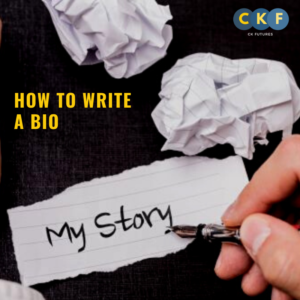 For executives, professionals, business owners,
For executives, professionals, business owners,
entrepreneurs & industry influencers.
The more noticed you become in your career, the more likely you are to be asked for a ‘Bio’.
AAAH! I hear you cry – I hate writing about myself – How do I do that? And why?
Reasons why you need a Bio: For when you deliver external talks, workshops, and presentations. It could be for your company website or for crowdfunding, investment, and due diligence processes. Maybe you’ve just written a book and now the publisher wants your Bio for the back cover. Whatever it’s for, getting your Bio right can help swing approval ratings in your favour.
You may have already written the ‘About’ section on your LinkedIn profile and made damn good use of the 2400 character limit. However, a professional Bio is different than the ‘About’ section on your LinkedIn. Bios are typically written in the third person (John Winter is the CEO….) because the person using your Bio is introducing you to other people. However, in the ‘About’ section on LinkedIn, you are introducing yourself to others, so your ‘About’ on LinkedIn needs to be written in the first person (I am the CEO of….).
So, this advice below is how to write a Bio for those occasions & events when other people or organisations are introducing you.
How to write your Bio:
1) Start with your name and state what you do. You want people to know and remember this. Even if this means writing your name again underneath the printed heading.
2) ‘Show’ what you do. Depending on the tone of your Bio, this is the bit where you need to describe what you do. Try to avoid just ‘telling’ them, if you can ‘show’ the reader it has more impact. Avoid vague statements such as ‘bringing sunshine into people’s lives’.
Formal toned example:
Charlotte is a professional CV Writer, LinkedIn Writer, and Interview Coach, working with people internationally to help them move confidently into the right job.
Relaxed toned example:
As Good Grubs’ content editor, Jenny does more than wrestle with grammar. With 9 years’ editorial experience at The Good Food Magazine, she’s obsessed with food and creates new stories that are absurdly useful and relevant for readers.
3) Describe ‘why’ you do what you do. What’s your background that’s led you to where you are today?
This is where you emotionally connect with your audience and is one of the most important parts of your Bio. It explains clearly what drives you, what your values are and differentiates you from others. If you get this right, the reader will love you, connect with you and remember you.
4) Include professional accomplishments. You need this bit in your Bio to build credibility with your audience. This part gives them reasons to trust you, makes them realise they can learn something from you and can keep them alert if you’re giving a talk. This part can also include professional qualifications as well as accomplishments. Qualifications alone are not enough but can re-enforce your subject matter expertise.
Think about the standout achievements in your career. What are the ones you want people to know about? Have you won any awards? Did you set a business up? Have you innovated? What clients have you worked with?
Example:
Marks’ clients include Harvard Business School, TEDx speakers and the United Nations. He has been a regular columnist in the New York Times and his last book ‘Fishing for Business’ has sold 11 million copies and been published in 10 languages.
* Watch out for: If you need your Bio for acquisition, business sale or investment processes, get your facts 100% accurate because they will probably be fact-checked during due diligence. For example, if you say you sold 11 million copies of a book, had a 10-year city finance career, or founded a business and sold it for £5m, you may be asked for documentation to back this up.
5) Include a splash of what you do outside of work. Can you connect your values and work to what you do outside of work? This could include family, sports, music, hobbies, charity work and sideshow stuff you get involved with. Depending on your audience and tone, you could include something quirky or funny.
Writing and presentation tips:
Tone – before you write your Bio, be clear on the purpose and ‘tone’ you need. Funny and snappy can grab the attention of readers but might miss the mark for some formal occasions.
Create mess – good writing comes out of messy notes, half-finished sentences, and captured ideas. No-one writes a perfect Bio straight off. Read other people’s Bio’s for inspiration, create mess, make changes, and ruthlessly edit it. Ask a professional or someone whose opinion you respect to check it.
Photo – all Bios need a headshot. If you’ve made it this far in your career, don’t blow it with a hammy home headshot. Hire a professional photographer.

Charlotte Eve
Charlotte Eve is an award winning CV Writer, LinkedIn Writer and Interview Coach, helping people internationally to move confidently into new roles. With an HR background, passion for writing and determination to pursue a ‘useful’ career, Charlotte set up C K Futures to support people most at risk in the job market. She is recognised by recruitment agencies, career coaches and back-to-work organisations nationwide as a specialist in helping people affected by redundancy, those seeking career change, individuals with complicated careers, parent returners and those with career gaps. Charlotte has helped more than 20,000 people into new roles, delivers her Masterclass Course to employment organisations and is sought out by businesses for her outplacement services. Also mum to two teenagers, Charlotte supports charities to help young adults and is a Youth Mentor.
